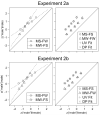Unequal-strength source zROC slopes reflect criteria placement and not (necessarily) memory processes
- PMID: 23565789
- PMCID: PMC3896244
- DOI: 10.1037/a0032328
Unequal-strength source zROC slopes reflect criteria placement and not (necessarily) memory processes
Abstract
Source memory zROC slopes change from below 1 to above 1 depending on which source gets the strongest learning. This effect has been attributed to memory processes, either in terms of a threshold source recollection process or changes in the variability of continuous source evidence. We propose 2 decision mechanisms that can produce the slope effect, and we test them in 3 experiments. The evidence mixing account assumes that people change how they weight item versus source evidence based on which source is stronger, and the converging criteria account assumes that participants become more willing to make high confidence source responses for test probes that have higher item strength. Results failed to support the evidence mixing account, in that the slope effect emerged even when item evidence was not informative for the source judgment (i.e., in tests that included strong and weak items from both sources). In contrast, results showed strong support for the converging criteria account. This account not only accommodated the unequal-strength slope effect but also made a prediction for unstudied (new) items that was empirically confirmed: participants made more high confidence source responses for new items when they were more confident that the item was studied. The converging criteria account has an advantage over accounts based on source recollection or evidence variability, as the latter accounts do not predict the relationship between recognition and source confidence for new items.
PsycINFO Database Record (c) 2013 APA, all rights reserved.
Figures







References
-
- Akaiki H. Information theory as an extension of the maximum likelihood principle. In: Petrov BN, Csaki F, editors. Second International Symposium on Information Theory. Akademiai Kiado; Budapest: 1973. pp. 267–281.
-
- Ashby FG, Townsend JT. Varieties of perceptual independence. Psychological Review. 1986;93:154–179. - PubMed
-
- Banks WP. Recognition and source memory as multivariate decision processes. Psychological Science. 2000;11:267–273. - PubMed
-
- Bröder A, Schütz J. Recognition ROCs are curvilinear – or are they? On premature arguments against the two-high-threshold model of recognition. Journal of Experimental Psychology: Learning, Memory, and Cognition. 2009;35:587–606. - PubMed
Publication types
MeSH terms
Grants and funding
LinkOut - more resources
Full Text Sources
Other Literature Sources
Medical

